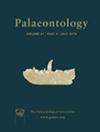The locomotor ecomorphology of Mesozoic marine reptiles
IF 2.3
2区 地球科学
Q1 PALEONTOLOGY
引用次数: 0
Abstract
The aftermath of the end‐Permian mass extinction provided ecological opportunities for many groups of reptiles, marking the beginning of reptile dominance of the Mesozoic oceans. Clades such as ichthyosaurs, thalattosuchians, sauropterygians, mosasaurs and turtles evolved a remarkable diversity of ecological niches and became important components of aquatic ecosystems. Locomotion is a key aspect of ecology, crucial for many biological functions such as foraging and migration. However, the evolution of locomotory adaptations across all Mesozoic marine reptiles remains poorly understood. Here we present multivariate and disparity analyses based on body proportions, body size and post‐cranial proxies for locomotion in 125 species of Mesozoic marine reptiles. Our analysis highlights key anatomical transformations in the evolution of swimming modes, characterizing two divergent evolutionary paths in the transition from drag‐based to lift‐based propulsion in both the axial and appendicular spectrum. Analyses against geological time do not show evidence for an explosive radiation after the end‐Permian extinction, pointing instead to a gradual increase in locomotory disparity during the whole Mesozoic, which reached the highest levels in the Cretaceous. Our analysis also provides insight into the evolution of locomotion in particular clades. Some notable findings are the high aquatic specialization in the earliest ichthyosauromorphs and the morphospace overlap between mosasauroids and ichthyosauromorphs.中生代海洋爬行动物的运动生态形态
二叠纪末大灭绝的后果为许多爬行动物群体提供了生态机会,标志着中生代海洋爬行动物主导地位的开始。鱼龙、地中海蜥、蜥脚目、摩萨龙和海龟等物种进化出显著的生态位多样性,成为水生生态系统的重要组成部分。运动是生态学的一个关键方面,对觅食和迁徙等许多生物功能至关重要。然而,对所有中生代海洋爬行动物运动适应的进化仍知之甚少。在这里,我们根据125种中生代海洋爬行动物的身体比例、体型和颅后运动指标进行了多元和差异分析。我们的分析强调了游泳模式进化中的关键解剖转变,在轴向和附件频谱上,描述了从基于阻力的推进向基于升力的推进过渡的两条不同进化路径。根据地质时间进行的分析并没有显示二叠纪末灭绝后存在爆炸性辐射的证据,而是表明整个中生代的运动差异逐渐增加,达到白垩纪的最高水平。我们的分析还提供了对特定分支中运动进化的见解。一些值得注意的发现是,最早的鱼龙形目具有高度的水生特化性,并且mosasauroids和鱼龙形目的形态空间重叠。
本文章由计算机程序翻译,如有差异,请以英文原文为准。
求助全文
约1分钟内获得全文
求助全文
来源期刊

Palaeontology
地学-古生物学
CiteScore
5.60
自引率
3.80%
发文量
43
审稿时长
6 months
期刊介绍:
Palaeontology publishes a wide variety of papers on palaeontological topics covering:
palaeozoology
palaeobotany
systematic studies
palaeoecology
micropalaeontology
palaeobiogeography
functional morphology
stratigraphy
taxonomy
taphonomy
palaeoenvironmental reconstruction
palaeoclimate analysis and biomineralization studies.
 求助内容:
求助内容: 应助结果提醒方式:
应助结果提醒方式:


